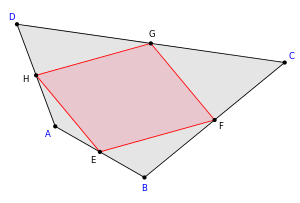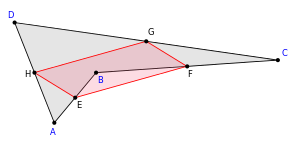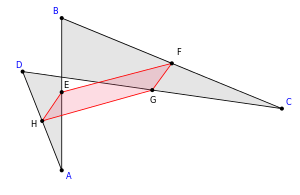Varignon's theorem

Varignon's theorem is a statement in Euclidean geometry by Pierre Varignon that was first published in 1731. It deals with the construction of a particular parallelogram (Varignon parallelogram) from an arbitrary quadrangle (quadrilateral).
- The midpoints of the sides of an arbitrary quadrangle form a parallelogram. If the quadrangle is convex or reentrant, i.e. not a crossing quadrangle, then the area of the parallelogram is half the area of the quadrangle.
If one introduces the concept of oriented areas for n-gons, then the area equality above holds for crossed quadrangles as well.[1]
The Varignon parallelogram exists even for a skew quadrilateral, and is planar whether or not the quadrilateral is planar. It can be generalized to the midpoint polygon of an arbitrary polygon.
Special cases
The Varignon parallelogram is a rhombus if and only if the two diagonals of the quadrilateral have equal length, that is, if the quadrilateral is an equidiagonal quadrilateral.[2]
The Varignon parallelogram is a rectangle if and only if the diagonals of the quadrilateral are perpendicular, that is, if the quadrilateral is an orthodiagonal quadrilateral.[3]:p.14
If a crossing quadrilateral is formed from either pair of opposite parallel sides and the diagonals of a parallelogram, the Varignon parallelogram has a side of length zero and is a line segment.
Proof
Varignon's theorem is easily proved as a theorem of affine geometry organized as linear algebra with the linear combinations restricted to coefficients summing to 1, also called affine or barycentric coordinates. The proof applies even to skew quadrilaterals in spaces of any dimension.
Any three points E, F, G are completed to a parallelogram (lying in the plane containing E, F, and G) by taking its fourth vertex to be E − F + G. In the construction of the Varignon parallelogram this is the point (A + B)/2 − (B + C)/2 + (C + D)/2 = (A + D)/2. But this is the point H in the figure, whence EFGH forms a parallelogram.
In short, the centroid of the four points A, B, C, D is the midpoint of each of the two diagonals EG and FH of EFGH, showing that the midpoints coincide.
A second proof requires less algebra. By drawing in the diagonals of the quadrilateral, we notice two triangles are created for each diagonal. And by the Midline Theorem, the segment containing two midpoints of adjacent sides is both parallel and half the respective diagonal. Therefore, the sum of the diagonals is equal to the perimeter of the quadrilateral formed. Secondly, we can use vectors 1/2 the length of each side to first determine the area of the quadrilateral, and then to find areas of the four triangles divided by each side of the inner parallelogram.
| convex quadrangle | reentrant quadrangle | crossed quadrangle |
|---|---|---|
|
|
|
|
See also
- Perpendicular bisector construction of a quadrilateral, a different way of forming another quadrilateral from a given quadrilateral
Notes
- ↑ Coxeter, H. S. M. and Greitzer, S. L. "Quadrangle; Varignon's theorem" §3.1 in Geometry Revisited. Washington, DC: Math. Assoc. Amer., pp. 52–54, 1967.
- ↑ de Villiers, Michael (2009), Some Adventures in Euclidean Geometry, Dynamic Mathematics Learning, p. 58, ISBN 9780557102952.
- ↑ Josefsson, Martin (2012), "Characterizations of Orthodiagonal Quadrilaterals", Forum Geometricorum 12: 13–25.
External links
- Weisstein, Eric W., "Varignon's theorem", MathWorld.
- Varignon Parallelogram in Compendium Geometry
- A generalization of Varignon's theorem to 2n-gons and to 3D at Dynamic Geometry Sketches, interactive dynamic geometry sketches.

